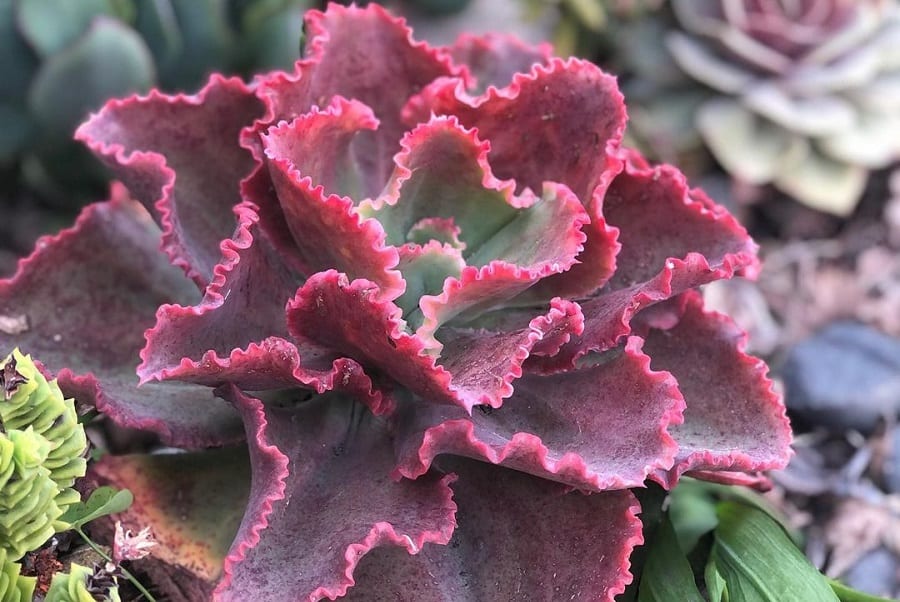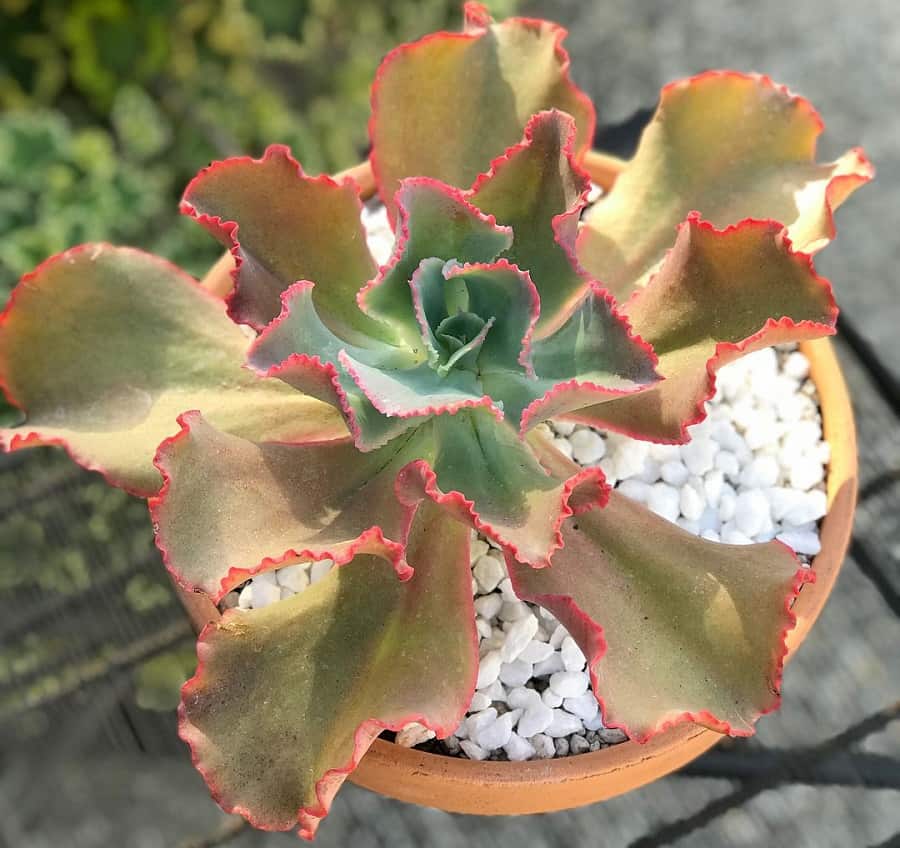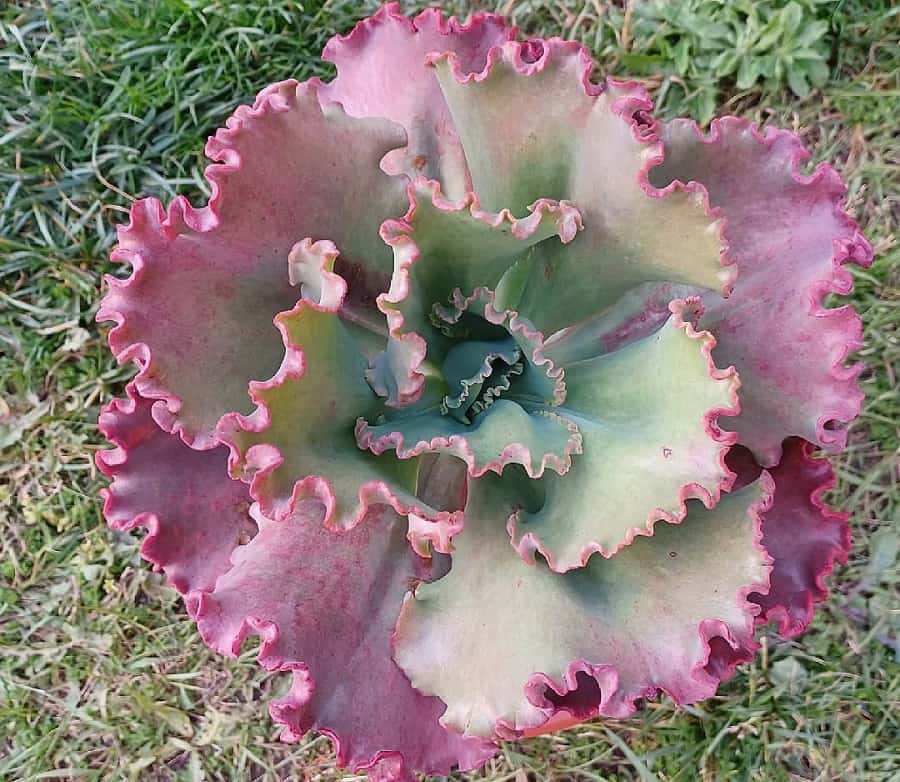Echeveria First Lady: Characteristics and Care
Rare, ruffled, and radiantly blushing – the Echeveria First Lady succulent is a true botanical beauty! With delicate yet sturdy leaves that transform from emerald green to a vibrant reddish-pink, this showstopping plant commands attention. If you’re looking to add a touch of elegant drama to your succulent collection, the appropriately named Echeveria First Lady is an absolute must-have. Get ready to be captivated by her ruffly charms!

Contents
About Echeveria First Lady
Native to the Americas, the Echeveria First Lady belongs to the Crassulaceae family and goes by a few other charming aliases like “Crinoline Ruffles” and “Ruffled Echeveria.” Its ruffled, waxy leaves give it an irresistibly delicate appearance, but don’t be fooled – this lady is tougher than she looks! With the right care, those seemingly fragile leaves will reward you with a stunning rosy blush.
Check this out:
160+ Amazing Echeveria Types with Pictures
Echeveria First Lady Care Guide
Light Requirements
To unlock the Echeveria First Lady’s full potential, provide her with plenty of bright, direct sunlight – we’re talking at least 4-5 hours daily. During the summer months, consider taking her outdoors to bask in those glorious rays. If you’re growing her indoors, a sunny windowsill or grow light will do the trick. Just be sure to rotate her periodically to ensure even sun exposure.
Watering Needs
Like most succulents, the Echeveria First Lady is a pro at conserving water in her plump leaves. Allow the soil to dry out completely between waterings, then give her a nice, deep drink – making sure any excess moisture drains away. Overwatering is a big no-no, as it can lead to root rot and other nasty issues. During the spring and summer growing season, you’ll need to water more frequently (around once a week), but cut back to every 2-3 weeks in the winter.

Soil Savvy
When it comes to soil, the key for the Echeveria First Lady is choosing a well-draining, porous potting mix. This succulent beauty simply won’t tolerate soggy soil situations! A standard cactus or succulent potting mix from your local nursery or garden center is the perfect option. These mixes are designed to provide excellent drainage and airflow to the roots, preventing issues like rot and fungal disease.
Fertilizing for Success
The Echeveria First Lady is a low-maintenance gal when it comes to fertilizing. Since she’s used to growing in nutrient-poor soils, she’s prone to fertilizer burn if you go overboard. If you want to give her a little boost, opt for a cactus or succulent fertilizer diluted to 1/4 of the recommended strength. Feed her every 2-3 weeks during the spring and summer growing season, and she’ll be radiant!
Temperature and Humidity
This succulent diva thrives in hot, dry conditions. Indoors, she’ll be happiest with temperatures between 65-80°F (18-27°C) in spring and summer, and a few degrees cooler in winter. Humidity-wise, aim for a nice, comfy 40-50% – too much moisture in the air can lead to rot. Outdoors, warm summers with temps around 70°F (21°C) or higher are ideal.
Pests and Problems
While the Echeveria First Lady is generally hardy, she can still fall victim to a few common succulent pests and issues. Keep an eye out for mealybugs, scale insects, and spider mites, which can be treated with insecticidal soap or neem oil. Root rot, caused by overwatering or poorly draining soil, is also a concern – so make sure her soil dries out fully between waterings.
Pruning Pointers
The Echeveria First Lady is a low-maintenance beauty when it comes to pruning. Simply remove any dead, damaged, or discolored leaves as needed to keep her looking her best. You can also trim off any leggy or stretched-out growth to maintain her compact, rosette shape.
Potting and Repotting

When it comes to containers, remember – the Echeveria First Lady likes it snug but not too cramped. Choose a pot that’s just slightly larger than her root ball to ensure proper drainage. And while she’s not a frequent repotter, you’ll want to size up her digs every couple of years or so as she grows. The best time for a repotting session? Early spring, right before her active growing period kicks in.
Echeveria First Lady Propagation Methods
Ready to multiply your Echeveria First Lady collection? This succulent diva is a pro at propagation through offsets, leaf cuttings, and seeds, giving you plenty of options to expand her reign!
Offsets:
- Look for the tiny rosette offshoots emerging from the main plant
- Gently twist or cut them off, ensuring you get some roots
- Allow the offsets to callus over for a few days before potting them up
Leaf Cuttings:
- Carefully twist off a healthy leaf from the mother plant
- Let it callus for 3-5 days
- Lay the calloused leaf on top of well-draining soil
- In a few weeks, you’ll see new baby plants sprouting!
Seeds:
- Use a well-draining seed starting mix
- Sow seeds on the surface and lightly cover with soil
- Keep soil moist but not soaked
- Provide bright, indirect light
- Once sprouted, wait for seedlings to develop true leaves before potting up
No matter which method you choose, have patience – propagating succulents takes a bit of time. But the rewarding process of watching new Echeveria First Ladies emerge is well worth the wait!
